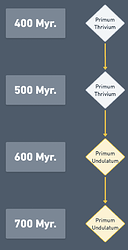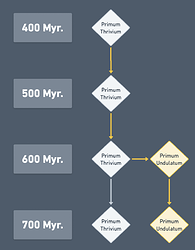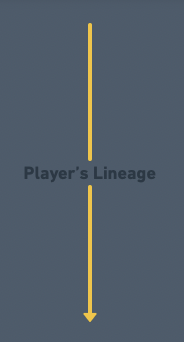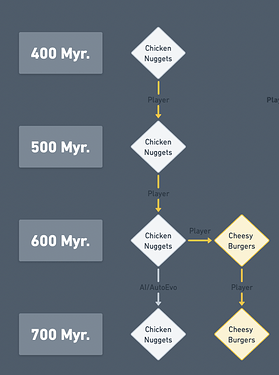This topic probably applies to multicellular and later stage gameplay as well. Currently when I evolve a new species, the species that i used to be vanishes, and now only this new species exists in the ecosystem. But i feel like this isn’t similar to evolution; When a new species splits off from an ancestor, the ancestor does not go extinct unless the new species outperforms it in it’s niche to the point of pushing it to extinction.
If a species splits off from a species, instead what should happen is the old species sticks around, or another offshoot that is slightly adapted from it outperforms it in it’s niche and pushes it to extinction. I think that especially during the early stages of the game, having your previous species stick around and act hostile towards you would make the game feel more realistic and populated with diversity.
Currently the game feels extremely empty as you evolve, because if you do well at your niche only your own species populates your environment, so having your previous species exist as well would help provide interesting gameplay whilst you wait for auto evo to catch up to you. I feel like an opportunity is being missed because you cannot actively compete with your previous self, and therefore cannot directly test which diversification is superior.
Another way I think this would help is by giving autoevo more opportunities to populate the world with organisms that are similar to you and compete for the same niche. If during one turn i develop an extremely capable predatory organism, when i evolve, it would be neat to compete agaisnt the previous predator example, and then if it somehow survives because both species compete for different niches, it could then create new offshoots on the same turn which are visibly related to but not the same as your own species. And then as the turns progress, it’ll lead to a more gradual radiation of diverse organisms filling different niches, with similar colors and shapes, but subtly different body layouts.
This also leads to a solution for another problem i’ve found; Often when playing the game, you are flying blind when adapting your species for the next turn inside of the editor, hoping that your new additions aid you inside of an unknown ecosystem. Whilst this can add a factor of fun where you need to be more strategic with what you’re adding, and aim to account for more posisble outcomes, it can also lead to a sudden extinction if a very unlikely change to the ecosystem occurs.
More than once the ecosystem has unexpectedly removed the niche that I was surviving in without warning from one turn to the next, due to how autoevo calculates the interactions between newly developed species. Additionally, tentative additions that I add as a test can suddenly make my species completely nonviable due to how it interacts with the environment, and whislt often this is fair, sometimes it can be impossible to predict how your addition will interact with a future state of the ecosystem.
I mention this because if previous examples of your species stick around almost completely unchanged (assuming they are capable of surviving inside the new ecosystem) it gives the option to revert to your previous species if your change interacts badly with the next iteration of the ecosystem. In it’s current state, the game can feel random in terms of what changes make or break your species fitness, because the ecosystem can become completely different in a way you cannot predict. So adding some sort of soft continuation where you revert to your closest common ancestor would help reduce these moments of seemingly random extinction.
In my opinion, the current state makes the environment seem almost too alien too quickly, with either vastly different expressions of your species showing up that don’t feel like a gradual evolution, or no adaptations occurring whatsoever for a while, and the player being left in a sea of only their own species. I think that adding this mechanic would help smooth out the adaptation of the environment and add a more broad spectrum of life to your game, making it feel more realistic.



